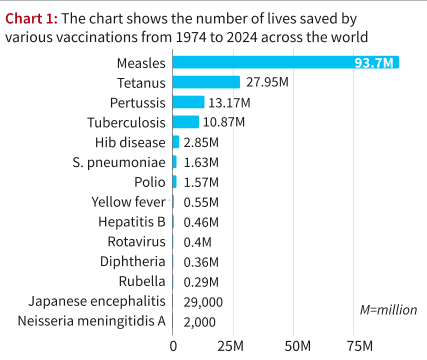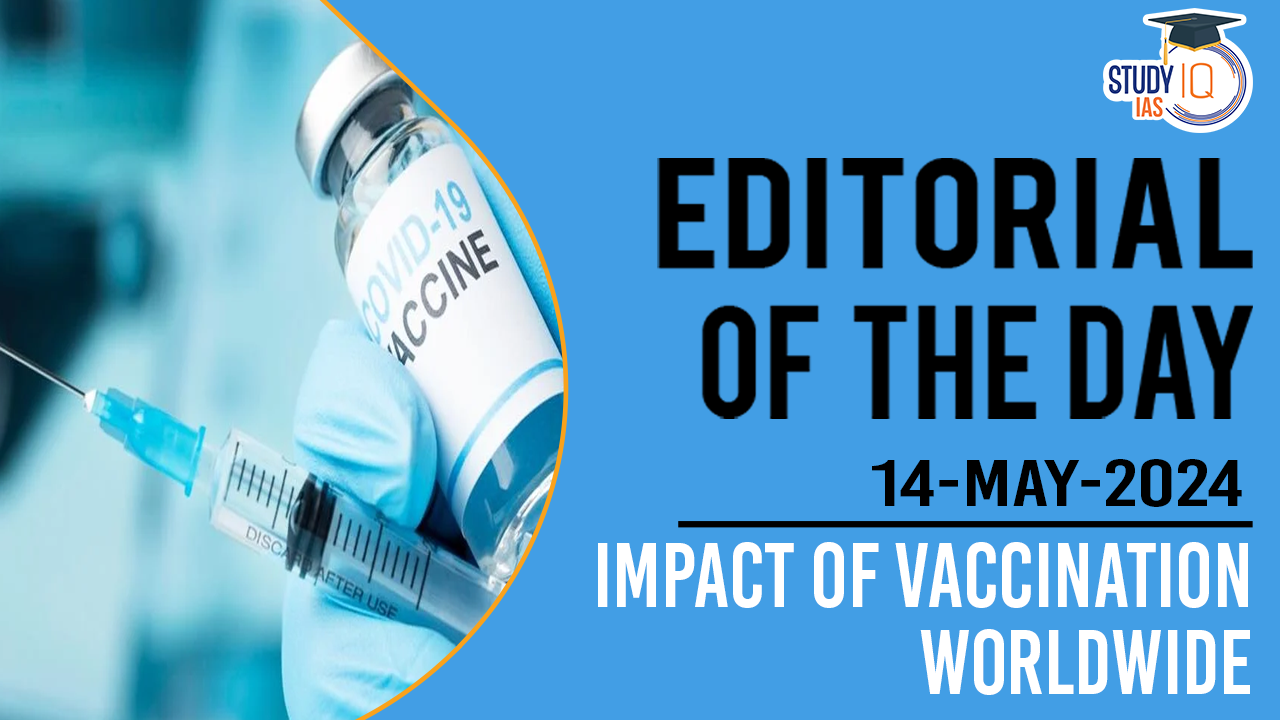Table of Contents
Context
- A new study published in the Lancet highlighted the remarkable impact of vaccinations in saving the lives of an estimated 150 million children over the past 50 years.
- Measles vaccination alone has been responsible for saving 60% of these lives, underscoring the importance of immunisation programs in reducing child mortality.
Key Findings of Lancet Study for Vaccination
- Measles Vaccination: 94 million lives saved, the highest among all vaccines.
- Tetanus Vaccination: 27.9 million lives saved.
- Whooping Cough (Pertussis) Vaccination: 13.17 million lives saved.
- Tuberculosis Vaccination: 10.87 million lives saved.

Reduction in Infant Mortality
- Infant mortality rates have declined from about 10% in 1974 to 3% in 2024.
- Vaccinations contribute to 40% of this decline.
Progress in Vaccination Coverage
| Disease | Data |
| Measles |
|
| DTP3 (Diphtheria, Pertussis, Tetanus) |
|
Global Efforts and Challenges
- Expanded Programme on Immunization (EPI): Established by the World Health Assembly, the decision-making body of the WHO in 1974, led to a significant rise in vaccination rates.
- Gavi, the Vaccine Alliance: Formed in 2000, helped address gaps in vaccination coverage, particularly in Africa and Asia.
Remaining Challenges
Despite progress, vaccine-preventable diseases still cause significant mortality:
- Tuberculosis causes over a million deaths annually.
- Measles, tetanus, whooping cough, meningitis, and hepatitis B collectively result in hundreds of thousands of deaths each year.
Call for Universal Vaccination
- Increased Investment: Governments need to invest more in universal immunisation programs.
- Coordination: Enhanced coordination is required to ensure vaccine availability and accessibility.
- Addressing Vaccine Hesitancy: Efforts to address vaccine scepticism and misinformation are crucial for achieving universal coverage.
About Expanded Programme on Immunization (EPI)
- Launched in 1974, following the near-eradication of smallpox.
- Aimed to leverage existing immunisation infrastructure and trained personnel to expand vaccine benefits.
- Ensures universal access to all relevant vaccines for all populations across the life course.
- Initially focused on protection against six childhood vaccine-preventable diseases: Bacillus Calmette-Guérin (BCG), diphtheria, pertussis, tetanus, polio, and measles1.
- Now includes vaccinations for older children, adolescents, and adults, expanding beyond the initial six diseases.
- Currently recommends 13 vaccines, including newer ones like Haemophilus influenza type B (Hib), Hepatitis B (HepB), rubella, pneumococcal disease (PNC), rotavirus (Rota), human papillomavirus (HPV), and COVID-19 for adults.
In India
- The Expanded Programme on Immunization was launched in 1978.
- It was renamed as Universal Immunization Programme in 1985 when its reach was expanded beyond urban areas.
- In 1992, it became part of the Child Survival and Safe Motherhood Programme.
- In 1997 it was included in the ambit of the National Reproductive and Child Health Programme.
- The Universal Immunization Programme is an integral part of the National Rural Health Mission (launched in 2005).
Success Story
Rising Immunisation Coverage
- Global Progress: Since the 1970s, immunisation coverage among children has increased significantly. In the early 1970s, only about 5% of children in low- and middle-income countries received three doses of the DPT vaccine.
- By 2022, this number had surged to 84% globally.
- Success in India: In India, the percentage of children receiving the recommended vaccines has consistently increased over the years, reaching 76% during 2019-2021.
Impact on Public Health
- Eradication and Elimination of Diseases: The use of vaccines has led to the eradication of smallpox and the elimination of polio from all but two countries. Many other vaccine-preventable diseases are now rare.
- Lives and Costs Saved: Vaccination programs have saved millions of lives and prevented billions of hospital visits and hospitalizations. Economic analysis suggests that every dollar spent on vaccinations yields a return of seven to 11 times the investment.
Dominance in Public Health Programs
- High Coverage: Immunisation programs have achieved higher coverage rates than almost any other health initiative in nearly all low- and middle-income countries, including India.
- Public Sector Dominance: Despite the significant role of the private sector in overall health services in countries like India, where they provide nearly two-thirds of such services, the public sector delivers 85% to 90% of all vaccinations.


 Bihar BPSC 70th Mains Result 2025 Out: C...
Bihar BPSC 70th Mains Result 2025 Out: C...
 Pax Silica Initiative: Meaning, Objectiv...
Pax Silica Initiative: Meaning, Objectiv...
 Tapanuli Orangutan: Habitat, Characteris...
Tapanuli Orangutan: Habitat, Characteris...

























